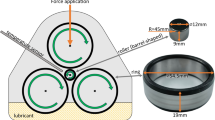Abstract
In order to study the effects of coal tar components on the adhesion strength of a heavy duty anticorrosive coating formed with tar-urethane resin on a steel plate, polyurethane coatings that were compounded with 15 kinds of polycyclic aromatic compounds as model coal tar components were prepared. In the model coal tar components, naphthalene, quinoline, 2-naphthol, and phenanthrene showed good compatibility with polyurethane. To test their heavy duty anticorrosive properties, tensile adhesion strength of the cured coatings prepared with the compatible model coal tar components was measured, and the change in tensile adhesion strength as a function of time during salt-water spray treatment was measured. We found that the systems compounded with naphthalene, 2-naphthol, and phenanthrene showed good properties in an ordinary state for adhesion strength. However, only the system with 2-naphthol was found to have good properties in the change of tensile adhesion strength as a function of time during salt-water spray treatment. The curing time of the system with 2-naphthol was slower than that of the others, i.e., we found an inverse proportion between curing speed and adhesion durability. We also measured the dynamic viscoelasticity of cured coatings. We found that a tan δ curve of the system with 2-naphthol shifted towards a low temperature side and the tan δ at the temperature at which adhesion strength was measured was larger than that of the others. We hypothesized that the reason for the tan δ shift was a result of the decrease in crosslinking density because 2-naphthol partially capped the isocyanate group. Considering these results, we hypothesized that one of the reasons why the adhesion properties of the system with 2-naphthol had improved was due to the increase of tan δ.
Similar content being viewed by others
References
Kano, H., Hama, S., and Inomata, S.,Toryo no Kenkyu, Japan, 129, 78 (1997).
Hama, S. and Kano, H., Proc. Annual Symposium on Anti-Rust and Anti-Corrosive Technology Society of Japan, 17, 187, 1997.
Akiyama, S., Kobunshi, The Polymer Society of Japan, 29, 819, 1980.
ISO 7253 (1984).
Sato, Y.,Anticorrosive Coating Technology, Japan. p. 95, Kogakutosyo, 1981.
Adhesion Handbook, The Adhesion Society of Japan, p. 40, Nikkankogyoushinbunsha, 1996.
Tsunoda, S.,Adhesion Technology, The Adhesion Society of Japan, 15, (3), 16, 1996.
Oki, Y.,Adhesion Technology, The Adhesion Society of Japan, 21, (1), 25, 2001.
Author information
Authors and Affiliations
Rights and permissions
About this article
Cite this article
Yokoyama, N., Fujino, K. Effects of model coal tar components on adhesion strength of polyurethane coating on steel plate. J Coat Technol Res 2, 445–451 (2005). https://doi.org/10.1007/BF02733887
Issue Date:
DOI: https://doi.org/10.1007/BF02733887




